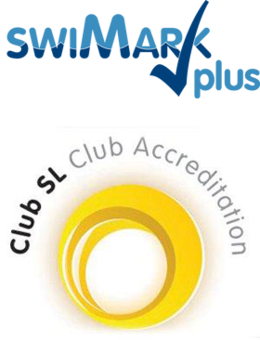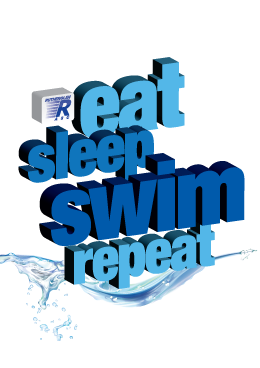Swim Meet Glossary
We hope this will help new swimmers and parents (and maybe some more experienced ones) understand a little better the terminology used at swim meets.
Age Group
Division of swimmers according to age. Age Group divisions can be such as: 10-under, 11-12, 13-14, 15-16, 17-18, 18 and over.
Anchor
The final swimmer in a relay.
ASA
Amateur Swimming Association – the ruling body of British swimming.
Backstroke
One of the 4 competitive racing strokes, basically any style of swimming on your back. Backstroke is swum as the first stroke in the Medley Relay and second stroke in the IM
Blocks
The starting platforms located behind each lane. Some pools have blocks at the deeper end of the pool, and some pools have blocks at both ends. Blocks have a variety of designs and can be permanent or removable.
Breaststroke
One of the 4 competitive racing strokes. Breasts is swum as the second stroke in the Medley Relay and the third stroke in the IM
Butterfly
One of the 4 competitive racing strokes. Butterfly (nicknamed FLY) is swum as the third stroke in the Medley Relay and first stroke in the IM
Course
Designated distance (length of pool) for swimming competition. Long Course = 50 metres / Short Course = 25 metres.
Deck
The area around the swimming pool reserved for swimmers, officials, and coaches. No one but an ‘authorised’ person may be on the deck during a swim competition.
Developmental
A classification of meet or competition that is usually held early in the season. The purpose of a developmental meet is to allow all levels of swimmers to compete in a lower pressure environment.
Disqualification (DQ)
A swimmer’s performance is not counted because of a rules infraction.
Entry
An Individual, Relay team, or Club event list in a swim competition.
Entry Fees
The amount per event a swimmer or relay is charged. This varies depending on the type of meet.
Electronic Timing
Timing system operated on DC current (battery). The timing system usually has touchpads in the water, junction boxes on the deck with hook up cables, buttons for backup timing, and a computer type console that prints out the results of each race. Some systems are hooked up to a scoreboard that displays swimmers time.
Event
A race or stroke over a given distance. An event equals 1 heat with its final, or a timed final.
False Start
When a swimmer leaves the starting block before the horn or gun. One false start may disqualify a swimmer or a relay team, although the starter or referee may disallow the false start in unusual circumstances.
False Start/Recall Rope
A recall rope across the width of the racing pool for the purpose of stopping swimmers who were not aware of a false start.
Fédération Internationale de Natation (FINA)
The international, rules making organisation, for the sport of swimming.
Finals
The final race of each event. The entries in a final may be decided by preliminary heats.
Final Results
The printed copy of the results for each race in a swim meet.
Flags
Pennants that are suspended over the width of each end of the pool approximately 5 metres from the wall.
Freestyle
One of the 4 competitive racing strokes. Freestyle (nicknamed Free) is swum as the fourth stroke in the Medley Relay and fourth stroke in the IM
Gallery
The viewing area for spectators during the swimming competition.
Graded Competition/Meet
Competition which a registered club swimmer may enter where their entry times are within specified time bands.
Heats
A division of an event when there are too many swimmers to compete at the same time. The results are compiled by swimmers time swum, after all heats of the event are completed.
Heat/Start Sheet
A finalised programme after withrawals have been processed and reserves have been allocated. This is usually produced during the warm-up.
Illegal
Doing something against the rules that is cause for disqualification.
Individual Medley (IM)
A swimming event using all 4 of the competitive strokes on consecutive lengths of the race. The order must be Butterfly, Backstroke, Breaststroke, and Freestyle. Equal distances must be swum of each stroke.
Invitational
Type of meet that requires a club to request an invitation to attend the meet.
Lane
The specific area in which a swimmer is assigned to swim. (e.g.) Lane 1 or Lane 2.
Pools with starting blocks at only one end: As the swimmers stand behind the blocks, (in a 6 lane pool) lanes should be numbered from Right (lane 1) to Left (lane 6).
Lane Lines/Ropes
Continuous floating markers attached to a cable stretched from the starting end to the turning end for the purpose of separating each lane.
Lap
One length of the course.
Lap Counter
The large numbered cards (or the person turning the cards) used during the freestyle events 400 metres or longer. Counting is done from the starting end.
Late Entries
Meet entries from a club or individual that are received by the meet host after the entry deadline. These entries are usually not accepted and are returned to sender.
Leg
The part of a relay event swum by a single team member. A single stroke in the IM.
Length
The extent of the competitive course from end to end. See lap.
Long Course
A 50 metre pool.
Marshalls
The adults (officials) who control the crowd and swimmer flow at a swim meet.
Meet
A series of events held in one programme. Also known as a Gala.
Meet Director
The official in charge of the administration of the meet. The person directing the ‘dry side’ of the meet.
Nationals
ASA senior, junior and age group meets conducted each year.
NGB
National Governing Body (the SASA)
NQT
National Qualifying Time
NT
No Time. The abbreviation used on a heat sheet to designate that the swimmer has not swam that event before.
Officials
The certified, or qualified adult volunteers, who operate the many facets of a swim competition.
Official Time (OT)
The swimmers event time recorded to one hundredth of a second (.01).
Open Competition/Meet
Competition which any qualified club, organisation, or individual may enter.
Oversubscribed (Oversub)
An entry that has not been accepted by the meet conveners. This can be for a number of reasons, e.g. constraints of time (see also “Scratch”).
PB
‘Personal Best’ – The best time a swimmer has done so far in a particular stroke/event
Qualifying Times
Published times necessary to enter certain meets, or the times necessary to achieve a specific category of swimmer.
Race
Any single swimming competition. (e.g.) preliminary, final, timed final.
Referee
The head official at a swim meet in charge of all of the ‘Wet Side’ administration and decisions.
Relays
A swimming event in which 4 swimmers participate as a relay team each swimmer swimming an equal distance of the race. There are two types of relays: 1.) Medley relay – One swimmer swims Backstroke, one swimmer swims Breaststroke, one swimmer swims Butterfly, one swimmer swims Freestyle, in that order. Medley relays are conducted over 200m and 400m distances.
2.) Freestyle relay – Each swimmer swims freestyle. Free relays are conducted over 100m, 200m, 400m, and 800m distances.
Reserve or Alternate (RES or ALT)
An entry that has been accepted provisionally on the condition that another accepted entry is withdrawn. Reserve entries should attend the meet session and await confirmation from the referee.
SASA
Scottish Amateur Swimming Association – the ruling body of Scottish swimming.
Scratch (SCR)
An entry that has not been accepted by the meet conveners. This can be for a number of reasons, e.g. constraints of time.
Seed
Assign the swimmers heats and lanes according to their submitted or preliminary times.
Nationals
National Long and Short course meets are held each year.
Session
Portion of meet distinctly separated from other portions by time.
Short Course
A 25-yard or more usually a 25 metre pool.
Split
A portion of an event, shorter than the total distance, that is timed. (i.e.) A swimmers first 25 or 50 time is taken as the swimmer swims the 100 race. It is common to take multiple splits for the longer distances.
Start
The beginning of a race. The dive used to begin a race.
Starter
The official in charge of signalling the beginning of a race and insuring that all swimmers have a fair take-off.
Stroke
There are 4 competitive strokes: Butterfly, Backstroke, Breaststroke, and Freestyle.
Stroke Judge
The official positioned at the side of the pool, walking the length of the course as the swimmers race. If the Stroke Judge sees something illegal, they report to the referee and the swimmer may be disqualified.
Submitted Time
Times used to enter swimmers in meets. The swimmer at previous meets must have achieved these times.
Swim-off
In a Heat/Finals type event, a race after the scheduled event to break a tie. The only circumstance that warrants a Swim-off is to determine which swimmer makes finals.
Timekeeper
The volunteers sitting behind the starting blocks/finish end of pool, who are responsible for getting watch times on events and activating the backup buttons for the timing system.
Time Trial
An event or series of events where a swimmer may achieve or better a required qualifying time.
Touch Out
To reach the touchpad and finish first in a close race.
Touch Pad
The removable plate (on the end of pools) that is connected to an automatic timing system. A swimmer must properly touch the touchpad to register an official time in a race.
Turn Judge
The official positioned at the end of the pool, watching the swimmers as they turn. If the Turn Judge sees something illegal, they report to the referee and the swimmer may be disqualified.
Unofficial Time
The time displayed on a read out board or read over the intercom by the announcer immediately after the race. After the time has been checked, it will become the official time.
Warm-down
The loosening a swimmer does after a race when pool space is available. Essential to avoid injury.
Warm-up
The practice and loosening session a swimmer does before the meet or their event is swam. Essential to avoid injury.



 .
. .
. .
.